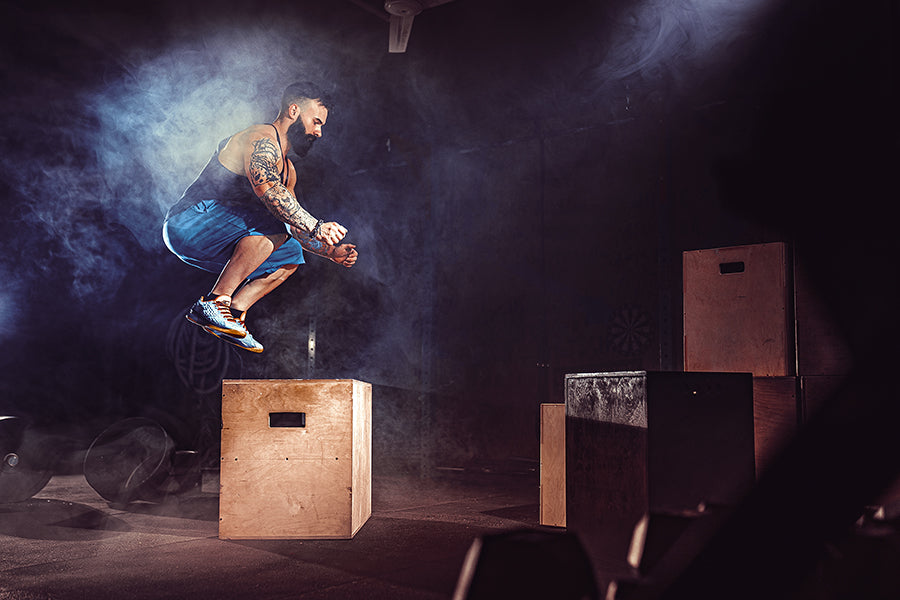Plyometrics is an exercise that focuses on increasing muscular strength and explosiveness by repeating explosive, high-intensity motions. Physical prowess and versatility can both benefit from plyometrics training.
Plyometrics workouts are often associated with improving sports performance, but anyone can benefit from increasing their strength and power with plyometrics.
There is some evidence that plyometrics training can assist athletes in enhancing game-specific abilities. This is especially true in sports where explosiveness—the capacity to produce force rapidly and in short bursts—is essential.
This article will discuss Plyometric Exercises in detail and will go through some basic exercises to build explosive strength.
What is Plyometrics
Plyometric training is a swift and forceful movement involving a set of reactive workouts, an eccentric contraction, and an explosive concentric contraction. This can be achieved by any physical activity that involves the Stretch-Shortening Cycle (SSC).
Plyo push-ups, as well as throws, runs, jumps, and kicks, are all examples of plyometrics. Athletes use plyometrics extensively, but everyone can benefit from the workouts. Many patients turn to plyometrics to regain mobility and strength after an injury or illness as part of their physical rehabilitation.
Plyometrics are an excellent way to challenge yourself if you are already in decent shape and are trying to make your workouts more challenging. This is a fantastic method to get in shape if you play a sport requiring a lot of jumping or running.
Plyometrics is a fun and challenging way to mix up any workout routine. However, similar to other training methods, it needs to be gradually introduced, instructed, and advanced to reduce the risk of injury.
Avoiding injury while performing unilateral and gravity-accelerated patterns like bounding, hop, depth jumps, and combination jumps calls for a high level of core strength, joint integrity, coordinated patterning, motor control, eccentric strength, flexibility, and technical expertise.
How Does It Work
Formerly known as "jump training" or "plyo," this exercise method has become increasingly popular in recent years. A wide variety of applications exist for this method. Plyometrics are a great way to get in shape for sports that require quick, powerful movements, such as basketball, volleyball, tennis, and many more.
A series of jumps and hops (e.g., jump squats, one-leg hops) will be performed. You may have to jump over a set of cones onto a box or a bench. Some moves will likely be quicker than others.
Whenever you land from a jump, you give your muscles a good stretch. Your subsequent jump will have greater force as a result. When you stretch and contract, your muscles get a good workout and are more toned.
3 Components of Plyometric Training
There are three stages to a plyometric exercise: the eccentric phase, the amortization period, and the concentric phase when the explosive force is released. A stretch-shortening cycle consists of the three parts listed above.
Eccentric Component
The muscle is pre-extended during the eccentric phase, and its elastic components accumulate potential energy. In physics, the eccentric phase is also known as absorption, deceleration, yielding, loading, or the cocking phase.
Examples of the eccentric part of a movement include a basketball player bending at the knees and lowering his arms before a rebound shot and a baseball player pulling his arms back before a throw to first base.
Amortization Component
There is a period of dynamic stabilization known as amortization, during which the muscle goes from resisting gravity's acceleration and loading energy to discharging it. There is a risk of losing potential elastic energy if this phase is performed too long.
Generally speaking, the results will carry more weight the shorter the amortization period is.
Concentric Component
Next, the muscle releases its elastic energy in the concentric phase, increasing the tension. Here's where the athlete lets either launch themselves into a dunk or fire the ball toward the outfield.
Benefits of Plyometrics
The muscles of a person's body can be trained to respond with power and efficiency with the help of plyometric exercises. The following are some of the potential benefits that could result from participating in this training process:
- Increased muscular force production in the body.
- Greater force in muscular contractions with a reduced need for overall energy expenditure.
- A faster rate of muscle contractions.
- Increased agility or nimbleness, is a term used by some fitness professionals to describe one's ability to shift direction quickly.
- A substantial improvement in general control during halting and starting movements.
- Increased vertical leaping distance.
- Reduced likelihood of sustaining damage to the muscles and joints.
An individual should collaborate with a trainer to develop a personalized training program. Using various workouts might help one concentrate on improving specific aspects of their performance.
Top 10 Plyometric Exercises
Whether you are a beginner or an experienced athlete, plyometric exercises can provide effective training that improves your aerobic and anaerobic capacities.
To get the most out of your training, consider including some of the top 10 plyometric exercises in your regular fitness regime.
1. Plyo Push-Up

Plyo Push-Ups are often overlooked, but they can be incredibly effective in a regular exercise routine. Not only do these push-ups increase strength and power, but they also elevate heart rate and help with muscular endurance.
- Start in a high plank position; your palms should be squarely beneath your shoulders, your torso should be straight, and your core should be firm.
- As if you were going to perform a pushup, lower your body until your chest is virtually parallel to the floor.
- Use enough energy to push yourself up so your hands lift off the floor. You can clap your hands together to increase the challenge, but it's not required.
- After a soft landing, start your next rep right away.
Related Article: 8 Awesome Benefits of Doing Push-Ups Every Day
2. Lateral Jump

A lateral jump is a great exercise that offers numerous benefits. By working the lower body muscles and increasing coordination, agile muscles become more robust and responsive. Balance is improved, and posture can benefit from a regular lateral jump program.
- Take a position halfway between a full squat and standing with your feet placed shoulder-width apart and your knees slightly bent.
- Jump sideways off both feet as if trying to clear a low barrier.
- Land softly in a partial squat with both feet.
- Make the same motion in the other way.
Once a person is confident in completing this exercise, they can increase the difficulty by starting in a half single-leg squat. They can push off the standing leg to jump to the side and lightly land on the other foot.
3. Box Jumps

Box jumps are a great exercise that targets your lower body muscles and can be done anywhere. They are an impactful plyometric exercise that helps to improve your cardiorespiratory endurance, power, strength, and agility.
- In front of the toes, place a box or other strong platform.
- Jump on the box while squatting a little, bending your knees so both feet fall on the box.
- Start with the arms by your sides and swing them forward and up while jumping for additional strength and stability.
Related Article: How to Do Box Jumps: The Right Way to Build Explosive Strength
4. Squat Jump

Squat jumps are an extremely effective exercise for strengthening your lower body muscles. This move engages the glutes, hamstrings, quads, and calves simultaneously. An added benefit is that you'll also get a good cardio workout from the repetitions. It involves these steps:
- Stand with your feet forward and your legs about shoulder-width apart.
- Squat while hunching forward and bending your knees and hips.
- Get into a squat and leap as high as you can.
- When you land from the jump, do it gently. Then, to begin the repetition, squat again.
5. Skater Jumps

Strength and explosiveness in the quadriceps and glutes can be improved with the help of skater jumps. They are more stable since all their weight is concentrated on one leg, and they jump with equal force distributed between both feet.
- Put your feet together in a squat and place most of your weight on your right leg.
- Your right leg should be pushed over to the side.
- As you complete a Curtsy Lunge, softly land on your left leg and step your right leg behind it.
- Continue with your left leg.
6. Lateral Box Shuffles

These are similar to skater jumps but emphasize agility and lateral foot speed more than explosive strength.
- A plyo box should be set up to the side at shin height.
- Put your right leg on the box and stand there. Keep your left foot lightly on the ground.
- Press into your right foot, bringing your left foot off the ground.
- Transfer weight onto your left foot which should now be on top of the box.
- Your right foot should be grounded on the opposite side of the box now.
- Repeat for a desired number of reps.
7. Barbell Squat Jumps

Compared to a standard Bodyweight Squat Jump, this workout adds weight, making it more challenging. You may jump higher by boosting your explosive strength and power when you do a standard jump, which feels much more straightforward. Do not increase the weight to the point that you cannot leap well.
- Load the barbell with enough weight for at least 10 repetitions.
- Get into a squat stance with your feet about shoulder-width apart after lifting the barbell off the rack.
- Squat, then suddenly leap off the ground.
- After a soft landing, start your next rep right away.
8. Broad Jumps

Because you do not take the first step or begin a running motion, broad jumps develop actual leg strength. They urge you to squat deeply and use your glutes and quadriceps to advance as far as possible.
- Squat down with your feet shoulder-width apart and face a clear area.
- Deeply squat and pull your arms backward before exploding upward and propelling yourself forward with your entire body.
- Immediately begin your next rep after a soft landing on the ground.
9. Scissor Jumps

This plyometric exercise is a jumping lunge performed in a different position. With the legs spread out, scissor jumps strengthen the glute and adductor muscles.
- Put yourself in a conventional lunge position with your knees and toes pointed forward and your back straight.
- Squat down, then explode up while reversing your leg position.
- After a soft landing, move on to your next jump right away.
- Repeat the movement while alternating the position of your legs.
10. Dot Drill

The Dot Drill improves foot swiftness and speed. Similar to Weighted Lateral Jumps, it also strengthens the ankle and calf muscles.
Drill 1:
- You can mark five points on a yoga mat or place a dot mat in front of you.
- Start by placing your feet on the mat's two corner dots at the front.
- Bring your feet together on the center dot as you jump a little off the ground.
- Without pausing, jump a little apart, and place each foot on a corner dot at the opposite end of the mat.
- Repeat without facing backward.
Drill 2:
- The second movement is identical to the first, but after moving forward to the far end of the mat, spin around and repeat the motion heading forward rather than backward.
Drill 3:
- You must hop on one leg to each dot in the third sequence.
- To begin, place a dot in the top right corner.
- Hop to the middle dot, the far right dot, the far left dot, and back to the middle dot, the front left dot, and back to the front right dot, all while standing on one leg. A rep is one.
- Put the opposite foot through the same motions.








